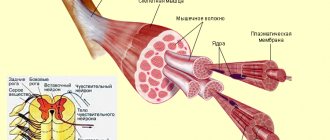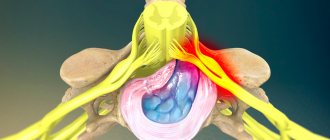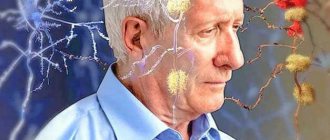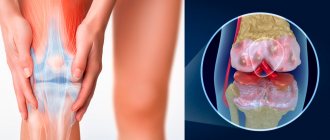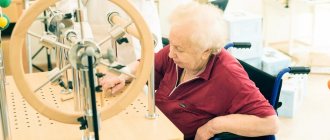Spinal cord injury and rupture is a dangerous condition that requires immediate treatment. Damage to the spinal cord and spine has serious consequences for the body, its various organs and systems. At the Yusupov Hospital, all conditions have been created to restore impaired functions in patients who have suffered a spinal injury:
- Comfortable living conditions;
- High-quality dietary nutrition;
- Professional care;
- Attentive attitude of medical personnel to the wishes of patients and their relatives;
- Application of innovative methods and proprietary physical rehabilitation programs.
Recovery from spinal cord injury can take a long time, and sometimes even a lifetime. The duration of the recovery period will depend on the extent of tissue damage, as well as the general condition of the body. A well-chosen rehabilitation plan allows you to restore maximum neuromotor functions and return a person to a full life. At the Yusupov Hospital, a spinal injury rehabilitation plan is drawn up individually, which makes it possible to obtain the best treatment results.
Causes
Spinal cord damage can be caused by congenital anomalies, various diseases and injuries of the spine. The latter include fractures, bruises, compression, dislocations, and concussions, accompanied by varying degrees of damage to tissue integrity. Injuries can occur as a result of a car accident, a fall, or receiving a perpendicular blow to the back (bullet wound, knife wound, blunt trauma).
The most dangerous is a rupture of the spinal cord. It is subject to long-term treatment and restoration of impaired functions. However, you must be prepared for the fact that with such an injury it is very difficult to fully recover, and in some cases, resuming the work of some organs and systems is not possible. In such a situation, psychologists at the Yusupov Hospital help the patient adapt to new living conditions.
Mortality
The highest risk of mortality occurs during the first year after injury and remains high compared with the general population. People with spinal cord injury are 2 to 5 times more likely to die early.
The risk of mortality increases with the level and severity of injury and is largely determined by the availability of timely and high-quality medical care. Factors such as the method of transport to hospital after injury and the time elapsed before admission to hospital are also important.
Secondary conditions that can be prevented (for example, infections from untreated pressure ulcers) are no longer considered the leading causes of death in people with spinal cord injury in high-income countries, but these conditions still remain the leading causes of death in people with spinal cord injury , in low-income countries.
Symptoms
Signs of a spinal cord injury usually appear immediately and do not raise doubts when making a diagnosis. When the spinal cord is damaged, the following symptoms occur:
- Impaired consciousness (disorientation, loss of consciousness, coma);
- Pain in the area of injury;
- Headache;
- Vomit;
- Double vision;
- Breathing disorders;
- Confusion of speech;
- Numbness of areas of the body below the affected area;
- Paralysis;
- Incontinence of feces and urine.
The most dangerous is considered to be damage to the spinal cord in the cervical region, since in this case there is a risk of developing paralysis of the entire body. With this injury, brain function is disrupted and breathing may stop.
Muscle spasm due to spinal cord rupture
A symptom of spinal cord injury may be muscle spasticity. In this condition, pathological muscle tone is observed, which increases with tension and passive movement. Spasticity does not allow you to control muscles, move freely, or speak.
It is characterized by involuntary muscle twitching, which is associated with impaired nerve conduction due to spinal cord injury. However, the presence of spasticity may indicate that the connection between the muscles and the brain remains. Thus, when the spinal cord is ruptured, spasticity is a good sign that increases the chances of restoring normal function of the limb.
Make an appointment
Symptoms of concussion and spinal cord contusion
- sharp and severe pain at the site of injury;
- weakness;
- numbness in the limbs;
- pain in the spine;
- loss of sensitivity in certain areas of the body, in the area of the destroyed part of the spinal cord;
- motor dysfunction;
- involuntary emptying of the bladder or bowels ;
- breathing problems ;
- spasms below the destruction zone;
- loss of consciousness;
- curvature of the back/neck;
- partial paralysis.
Compression of the spinal cord occurs when the vertebral bodies or their fragments are displaced, as well as when hematomas form and cerebral edema. There may be loss of sensory activity and inability to move limbs or the entire body.
The most complex injuries lead to disorders of the intestinal organs, urinary system, respiratory systems and blood vessels. Often, victims suffer from chronic pain.
Spinal cord injuries affect not only the physical level, but also the psychological one. A person may experience impaired reaction speed, poor coordination, sudden mood swings, aggression, fear or a feeling of loss, anxiety, decreased appetite , and depression.
The most serious consequences of spinal cord injury are:
- paralysis of the whole body or individual parts;
- disability;
- Difficulty with digestion and bowel movements;
- deep vein thrombosis
- bedsores;
- muscle spasticity (constant tension);
- Impaired lung function (breathing problems).
Important! Any back injury requires urgent contact with a doctor, an ambulance or the nearest emergency room. After any spinal injury, immediate care is extremely important. The sooner a qualified neurosurgeon stops the pathological process in the spine, the less pronounced the consequences will be. Do not delay rehabilitation measures to eliminate long-term consequences of a spinal cord injury.
To clarify the diagnosis, radiography , and, if necessary, computed tomography and magnetic resonance imaging (CT, MRI), which can help identify blood clots in the spinal substance. An X-ray of the spine will help determine the location of the injury and the type of injury. A lumbar puncture (lumbar puncture, spinal tap, lumbar puncture) and myelography may also be needed.
Hematomyelia is bleeding in which blood may accumulate in a hematoma, or fill a component of the spinal cord. It spreads along it, causing the destruction of nerve tissue, compression of motor pathways and brain structures. Causes partial damage to the spinal cord, but can affect the entire diameter. Accompanied by excessive bleeding into the space of the brain.
Consequences
A spinal fracture with damage to the spinal cord leads to serious consequences for the body. Their severity will depend on the extent of tissue damage, the timeliness and quality of treatment measures. Minor injuries damage peripheral nerve cells. Their work can be taken over by healthy neurons. In this case, the consequences will be minor.
If deeper layers of the spinal cord are affected, the consequences can be catastrophic. The patient may die or remain disabled. The brain completely loses connection with the body below the area of spinal cord injury, which leads to complete loss of sensitivity in this area and immobilization.
After a severe spinal injury, a person experiences a state of shock that puts him into a coma. This is the body’s protective reaction to damage that has occurred. Spinal shock can last from several days to several weeks. At this time, all organs and systems (except for the heart and lungs) do not work correctly, so it is impossible to check reflexes and determine the full picture of damage. Muscles atrophy during a comatose state, so rehabilitation clinic specialists maintain their tone with massage, gymnastic exercises and electrical impulses.
The most serious consequences of spinal cord injury include:
- Paralysis of the whole body or individual parts;
- Difficulty with digestion and bowel movements;
- Deep vein thrombosis;
- Bedsores;
- Muscle spasticity;
- Impaired lung function (breathing problems.)
Long-term consequences of spinal cord injury can occur with inadequate rehabilitation. Therefore, it is very important to complete the full course of treatment and take preventive measures to maintain the functioning of the body.
Types of spinal injuries
In general, the spine consists of 33 vertebrae, between which are located cartilaginous plates (intervertebral discs). Almost all vertebrae have a bony arch and processes extending from it. A hole is formed between the vertebral body and the arch, the position of which coincides in each spinal motion segment throughout the entire spinal column. The canal formed in this way is called the spinal canal, in which the delicate nervous structure - the spinal cord - is located. A pair of nerve roots depart from it at the level of each vertebra, which together are responsible for the innervation of the entire body.
Each of these anatomical structures can be injured. As a result, they distinguish:
- spinal bruises are the mildest injuries in which mechanical injury to soft tissues is observed, but the integrity of bone structures, intervertebral discs and ligaments is not compromised;
- fractures of the vertebral bodies - can be compression, in which the vertebra is flattened on one side, or comminuted, in which individual bone fragments are formed;
- fractures of the processes and/or arches of the vertebrae;
- vertebral dislocations - a change in the position of the bones that form the joints of the spine (sometimes the dislocation can be self-correcting);
- fracture-dislocations of the vertebrae;
- spondylolisthesis – displacement of the upper vertebral body anteriorly relative to the lower one, which also leads to sprained ligaments;
- partial or complete rupture of the ligaments of the spinal motion segment (distortion) - a minor injury, usually with a favorable outcome;
- intervertebral disc rupture – instantaneous formation of a disc herniation under the influence of a traumatic factor;
- spinal cord concussion – a change in the condition of the spinal cord that is reversible over time;
- contusion of the spinal cord and/or its roots - with rapid restoration of blood flow and elimination of compression, the consequences can be reversible;
- partial or complete rupture of the spinal cord and/or its roots is the main cause of disability.
All these types of damage can be combined with each other in different combinations, so 3 types of spinal injuries can be distinguished:
- uncomplicated spinal injury – accompanied by a violation of the integrity of the spinal structures without affecting the spinal cord;
- spinal cord injury without damage to the spine - consists of damage to the spinal cord;
- spinal cord injury – accompanied by a combination of damage to the spinal column, spinal cord and neurovascular formations of the spinal canal.
In 40-60% of patients with spinal cord injury, damage to internal organs and other tissues is observed.
Like other injuries, spinal injury, depending on the nature of the violation of the integrity of the skin, can be closed, open or penetrating. It is very important to determine exactly how much time has passed since the injury. Depending on this, 5 periods are distinguished:
- acute – up to 8 hours;
- acute – 8-72 hours;
- early – from 3 days to 4 weeks;
- intermediate – 1-3 months;
- late – more than 3 months.
All spinal injuries can be divided into stable and unstable, which largely influences the nature of the necessary treatment.
Accurately determining the type of injury and the period in which the patient is currently in is extremely important for the correct development of treatment tactics. Therefore, after providing emergency care to a patient, a comprehensive diagnosis is always carried out.
Why is a spinal cord rupture dangerous?
Spinal cord rupture is a very serious condition that leads to disability and threatens a person’s life. When the spinal cord is ruptured in areas of the body below the rupture site, communication with the brain is disrupted and they lose their functions.
A particularly severe complication of spinal cord rupture is spinal shock. The duration of spinal shock cannot be predicted. It can be several weeks or months. At this time, it is necessary to support the body and take measures to prevent muscle atrophy.
A rupture of the spinal cord poses a direct threat to human life. If the most difficult period can be survived, the person will need to undergo a long course of rehabilitation to adapt to life with a disability.
WHO activities
WHO works across the spectrum, from primary prevention of traumatic and atraumatic causes of spinal cord injury, improving trauma care, strengthening health and rehabilitation services, and supporting the inclusion of people with spinal cord injury in society. WHO performs the following tasks:
- works on an interagency basis in partnership with national stakeholders across a variety of sectors (e.g. health, law enforcement, transport, education) to improve the prevention of spinal cord injuries, including from road traffic accidents, falls, acts of violence and nerve defects tubes;
- guides and supports Member States in raising awareness of disability issues and promotes the inclusion of disability as a component of national health policies and programmes;
- promotes the collection and dissemination of disability-related information and data;
- develops normative tools, including guidelines and good practices, to strengthen primary prevention (motor vehicle crashes, falls and violence), trauma care, health care, rehabilitation and support, and other care;
- builds appropriate capacity among health policymakers and service providers;
- promotes the expansion of rehabilitation work at the local level; And
- promotes strategies to ensure that persons with disabilities are well informed about their health conditions and that health care personnel support and protect the rights and dignity of persons with disabilities.
Rehabilitation for spinal cord injury
Recovery of the spinal cord after injury consists of many activities. Rehabilitation begins as early as possible. Rehabilitation measures include:
- Performing physiotherapeutic procedures;
- Physical therapy;
- Massage.
Leg massage after a spinal cord injury allows you to normalize the flow of blood and lymph in the lower extremities and restore nerve conduction. The implementation of rehabilitation must be constantly monitored by specialists. It is necessary to monitor the body's response to the therapy and make timely adjustments.
Make an appointment
Vascular diseases of the spinal cord
Vascular diseases of the brain and spinal cord are caused by a disorder that leads to a decrease in oxygen saturation of the spinal cord and brain and, as a consequence, to disruption of the metabolism of neuroglial populations.
Hemorrhages are less common, but prognostically they are a very serious group of cerebrovascular diseases. Doctors encounter bleeding more often in patients taking anticoagulants or antiplatelet agents, people with coagulopathy or amyloid angiopathy.
Causes
Local reasons:
- developmental pathologies;
- arteriosclerosis of the afferent vessels or fibrosis of the arteries of the brain or spinal cord;
- inflammatory vascular diseases (syphilis, herpes zoster, borreliosis);
- aortic surgery (aneurysm, dissection);
- spontaneous dissection of the aortic wall due to thinning;
- vasculitis;
- trauma (often along with cervical myelopathy);
- embolism (spontaneous, iatrogenic);
- spinal angiography;
- post-radiation damage to the vascular wall;
- inflammation caused by bacteria and viruses.
Common reasons:
- hypoxia (including in newborns);
- hypoperfusion;
- heart failure;
- hypovolemia (absolute or relative);
- venous infections of the spinal cord that occur with sepsis and malignant tumors.
The causes of bleeding into the spinal canal are different. The most common vascular malformations (venous angiomas, AV anomalies) are formed by unevenly distributed vessels in the spinal cord and leptomeningeal space with the most common localization in the Th-L junction.
Manifestations
Each spinal cord pathology has its own typical manifestations.
Intermittent spinal cord insufficiency is characterized by repeated reversible ischemic symptoms (paraparesis, pyramidal phenomena, paresthesia of the lower extremities, sensitivity disorders, etc.). When signs appear when walking, most often in older people, we are talking about intermittent claudication:
- disorders in the cervical spine - attacks of falling;
- lesions in the lumbar region - spinal claudication (weakness of the lower extremities during physical activity, disappearing at rest).
In myelomalacia with long-term damage, the clinical picture is varied and corresponds to a focal disorder, both in the vertical and horizontal directions. Transverse ischemia damage can be divided into several syndromes according to blood supply.
Hematomyelia:
- back pain in combination with radicular symptoms;
- incomplete transverse lesion syndrome;
- dissociated sensitivity disorder in the affected segment, distal spasticity;
- Brown-Sequard syndrome.
Epidural hematoma:
- severe back pain, sometimes radiating to the pelvic area;
- paraparesis of the lower extremities;
- sphincter disorders.
Spinal ischemia:
- severe local pain;
- meningeal symptoms.
In cysts, fistulas, and malfomations, the signs are most often localized in the Th-L junction. They usually appear suddenly, less often - slowly, gradually. Initially, local or radicular pain occurs. Often, already in the early stages of the disease, urination disorder occurs, which can be used as part of the differential diagnosis for tumors or other compressions.
Often the course of diseases fluctuates with more or less complete remissions.
Diagnostics
In the case of sudden paraparesis or tetraparesis of the lower extremities, it is first necessary to exclude other causes known in neurology, in particular the expansion process leading to compression of the spinal cord (tumor, hernia, hemorrhage, etc.). These conditions would require urgent neurosurgery.
Diagnostic methods:
- MRI;
- biochemical examination;
- CT angiography of the aorta (excluding dissection or other pathology, for example, thrombotic aneurysm, etc.);
- spinal angiography (detection of malformation);
- study of biomarkers (if myelitis, Guillain-Barré syndrome and multiple sclerosis are suspected).
Treatment
Treatment of spinal cord ischemia is similar to that of ischemic stroke. In patients who have experienced a bleeding episode due to a vascular malformation, an aneurysm, there is a need to choose between interventional radiology and thromboticization of the bleeding source or a surgical solution.
Traumatic spinal cord disease
Medical scientists distinguish the following periods of traumatic spinal cord disease (TSCD):
- Acute period. Lasts about 3 days. As a rule, at this time, symptoms of spinal shock appear, such as loss of tendon and visceral reflexes, loss or impairment of movements, decreased muscle tone, loss of sensitivity;
- Early period. Lasts about 3 weeks. During this period, a gradual restoration of reflex excitability begins. It gradually turns into hyperreflexia, muscle tone also increases and clinical activity appears;
- Intermediate period. Lasts about 2-3 months. The beginning of the period is considered to be the time from the moment of injury. A predominance of extensor or flexor muscle tone begins to form. Contracture in the joints, spasticity and muscle wasting may also appear;
- Late period. Lasts about a year. At this time, a gradual unidirectional deterioration or improvement of the patient’s condition occurs;
- Residual period. Lasts more than a year from the moment of injury. During this period, the consequences of the injury and residual effects appear, as well as the formation of a new level of neurological functions that will be permanent.
Most experts argue that surgical operations for traumatic spinal disease should be performed as quickly as possible. Surgical interventions performed more than three days after injury, as a rule, are ineffective due to the fact that irreversible changes may develop during this period and their implementation will be difficult for a number of reasons.
Any surgical intervention, the purpose of which is decompression of the spinal cord, is accompanied by revision of the spinal cord using optical magnification. This audit reveals the presence of intracerebral hematomas and intrathecal hemorrhages. They are removed immediately, otherwise they can cause the formation of cysts and scars. Very quickly, adhesions form, which are located between the substance of the spinal cord, the membranes and the nerve roots. This greatly complicates the operation, as it requires the use of strong optical magnification and micro-instruments.
Surgical intervention is impossible in the presence of traumatic shock, concomitant injuries to internal organs, acute respiratory failure and early septic complications of the disease. With complete damage to the spinal cord, the main goal of treatment is to improve segmental functions. This treatment method has had great success recently.
Improving health care and problem solving
Many of the consequences associated with spinal cord injury are not due to the condition itself, but to inadequate levels of medical care and rehabilitation services, as well as physical environmental, social, and policy barriers.
Implementation of the UN Convention on the Rights of Persons with Disabilities (CRPD) requires appropriate action to address these gaps and challenges.
Key interventions to improve the survival, health, and social participation of people with spinal cord injury include the following:
- Timely and appropriate examination before admission to the hospital: prompt recognition of injury with suspected spinal cord injury, rapid assessment and implementation of first aid measures for the victim, including spinal immobilization.
- Emergency care (including surgery) appropriate to the type and severity of injury, degree of instability and presence of nerve compression, and in accordance with the wishes of the patient and family.
- Access to available health care, information materials and medical products (such as catheters) to reduce the risk of secondary conditions and improve quality of life.
- Access to qualified rehabilitation and mental health services to maximize recovery of function, independence, general well-being and inclusion in the community. Maintaining bladder and gastrointestinal function is extremely important.
- Access to appropriate assistive devices that can enable people to carry out activities of daily living that they would otherwise be unable to do, thereby reducing functional limitations and dependency. In low- and middle-income countries, only 5-15% of people have access to the assistive devices they need.
- Specialized knowledge and skills among health and rehabilitation professionals.
Necessary measures to ensure the right to education and economic participation include legislation, policies and programs that provide assistance in the following areas:
- creating physically accessible homes, schools, jobs, hospitals and transport;
- creating an education system for all;
- eliminating cases of discrimination at work and in education;
- rehabilitating skills to optimize employability;
- microfinance and other forms of self-employment benefits to support alternative forms of self-sufficiency;
- ensuring access to a social benefit system that does not act as a disincentive to return to work;
- a proper understanding of the problem of spinal cord injury and a positive attitude towards people who live with this condition.
Surgical intervention
Surgery may be required to treat the injury. The operation (decompression of the spinal cord) must be performed as soon as possible (in the first four hours after spinal injury), since then one can hope for a favorable outcome of the disease.
Indications for surgery may be as follows:
- noticeable deformation of the spinal canal due to X-ray positive or negative, or compressive structures;
- block of liquor pathways;
- rapid development of spinal cord dysfunction;
- worsening acute respiratory failure, which was provoked by swelling of the cervical spinal cord;
- signs (clinical and angiographic) of compression of the main vessel of the spinal cord.
There are a number of contraindications in the presence of which the operation cannot be performed:
- severe traumatic brain injury, which is accompanied by disturbances in the level of consciousness and suspected intracranial hematoma;
- damage to internal organs (risk of developing peritonitis, internal bleeding, heart contusion with accompanying symptoms of heart failure, rib damage);
- traumatic or hemorrhagic shock;
- severe diseases accompanied by anemia, renal, cardiovascular and liver failure;
- fat embolism, unfixed limb fractures, pulmonary embolism.
In the early period after stabilization of the patient’s condition, it is necessary to create favorable conditions for his effective rehabilitation. Doctors also focus on preventing or treating complications of injury. Damage to the spine is accompanied by a number of serious complications, which can be divided into four large groups:
- Infectious and inflammatory complications arise due to the development of infection in the body; they can be late or early. Early complications of injury include purulent epiduritis (inflammation affects the epidural tissue), spinal cord abscess, and purulent meningomyelitis. In the later stages of the pathology, serious complications such as epiduritis and arachnoiditis can occur.
- Trophic disorders are ulcers and bedsores that arise due to disruption of tissue trophism caused by damage to the spinal cord. Bedsores go through several stages of formation: necrosis (this stage is characterized by tissue decay), epithelization (active growth of epithelium), the appearance of granulations, trophic ulcers (occur if the pathological process does not lead to scarring of the bedsore).
- Damage to the pelvic organs is accompanied by urinary retention. Bladder dysfunction is often complicated by the development of an infectious process in the urinary tract, which can provoke urosepsis. Patients can be diagnosed with different forms of neurogenic bladder: hyporeflex, normoreflex, hyperreflex, arereflex.
- Deformations of the musculoskeletal system are manifested by scoliosis and kyphosis. These pathologies arise due to paralysis and paresis of the trunk muscles, which provoke a violation of statics. Patients may also be diagnosed with limb deformities due to neurogenic arthropathy and impaired muscle tone.
Successful rehabilitation of patients depends on the speed of recovery processes in the spinal cord. It is quite possible to stimulate them with the help of drug therapy, therapeutic exercises, and physiotherapy. The patient is prescribed drugs that normalize metabolism, improve oxygen supply to the spinal cord, and mitigate the formation of glial tissue. Such medications include nootropics, anabolic hormones, immunoactive drugs, muscle relaxants, sedatives and tranquilizers.
Physiotherapeutic treatment involves the use of one or several techniques:
- UHF inductothermy, which affects the lesion in an oligothermic dose;
- UHF electric field: affects the lesion in a low-thermal or non-thermal dose;
- longitudinal galvanization (carried out with the application of electrodes near the lesion);
- mud applications (in the case of medicinal treatment, it is prescribed from the second week after injury, in the case of surgical treatment - immediately after the removal of the sutures).
Therapeutic exercises are prescribed according to indications, depending on the degree of spinal damage. The stable nature of the fracture and the absence of severe spinal cord disorders are considered indications for performing special physical exercises almost immediately after the patient is hospitalized. The primary objectives of therapeutic exercises are: improving the functioning of the respiratory and cardiovascular systems, preventing muscle atrophy, and having a general tonic effect.
In the early period, patients are recommended to perform breathing exercises, as well as exercises to work out the distal parts of the limbs. Then, movements in which the spinal muscles should participate are gradually added to the set of exercises. If the patient has been damaged in the cervical spine, all exercises are performed initially in a lying position, and over time, sitting and standing.
If the cervical spinal cord is damaged, patients are advised to perform breathing exercises. Its main tasks are to increase gas exchange in the lungs and strengthen the muscles that are involved in breathing. First, patients learn static breathing exercises, especially diaphragmatic breathing training. A week after injury or surgery, you can begin to perform dynamic exercises. In the acute period of the disease, the duration of classes should be no more than 3-5 minutes. As the patient's condition stabilizes, this time may increase.
Prognosis for spinal cord injury
The outcome of treatment and the prognosis for the patient depend on the severity and location of the injury, the age of the patient, timely provision of first aid and adequate treatment. Often the prognosis for the patient’s health and life becomes known after intraoperative monitoring of the spinal cord. However, a macroscopically normal spinal cord does not always indicate the possibility of reverse development of the pathological process and recovery of the patient. If, after a spinal injury, the syndrome of complete disruption of spinal cord conduction persists for two days, and minimal regression of sensory and motor disorders is not observed, the patient’s chances of recovery are minimal.
The statistics of spinal cord injuries are disappointing. At least 37% of all victims die before medical assistance is provided. Another 13% of victims die in hospital. After the operation, the mortality rate is 4-5%. If compression of the spinal cord is combined with its contusion, the mortality rate increases to 15-70%, depending on the severity of the injury. Complete recovery of patients after cutting and puncture injuries is observed in 8-20% of all cases. For gunshot wounds, this figure is 2-3%. All complications that arise during the treatment of a spinal injury reduce the chances of a complete recovery of the patient and increase the risk of death.
A favorable course of the disease can be achieved if spinal deformity and spinal cord compression are eliminated as completely and rationally as possible, and effective prevention of urological complications and bedsores is prescribed. Timely and comprehensive rehabilitation after treatment of injury will allow patients to fully restore impaired functions.
Complete surgical decompression of the spinal cord in the early stages can increase the patient’s chances of recovery. Improvement is also observed after surgery in the treatment of injuries to the cervical, lumbar and lower thoracic spinal cord. Thanks to the implantation of innovative fixation systems into the spine, patients have the opportunity to begin rehabilitation as early as possible, which helps prevent bedsores and other dangerous complications.
